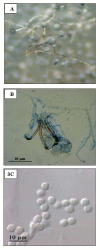Usefulness of molecular biology performed with formaldehyde-fixed paraffin embedded tissue for the diagnosis of combined pulmonary invasive mucormycosis and aspergillosis in an immunocompromised patient
- PMID: 20205795
- PMCID: PMC2823679
- DOI: 10.1186/1746-1596-5-1
Usefulness of molecular biology performed with formaldehyde-fixed paraffin embedded tissue for the diagnosis of combined pulmonary invasive mucormycosis and aspergillosis in an immunocompromised patient
Abstract
Immunocompromised patients who develop invasive filamentous mycotic infections can be efficiently treated if rapid identification of the causative fungus is obtained. We report a case of fatal necrotic pneumonia caused by combined pulmonary invasive mucormycosis and aspergillosis in a 66 year-old renal transplant recipient. Aspergillus was first identified during the course of the disease by cytological examination and culture (A. fumigatus) of bronchoalveolar fluid. Hyphae of Mucorales (Rhizopus microsporus) were subsequently identified by culture of a tissue specimen taken from the left inferior pulmonary lobe, which was surgically resected two days before the patient died. Histological analysis of the lung parenchyma showed the association of two different filamentous mycoses for which the morphological features were evocative of aspergillosis and mucormycosis. However, the definitive identification of the associative infection was made by polymerase chain reaction (PCR) performed on deparaffinized tissue sections using specific primers for aspergillosis and mucormycosis. This case demonstrates that discrepancies between histological, cytological and mycological analyses can occur in cases of combined mycotic infection. In this regard, it shows that PCR on selected paraffin blocks is a very powerful method for making or confirming the association of different filamentous mycoses and that this method should be made available to pathology laboratories.
Figures



References
-
- De Pauw B, Walsh TJ, Donnelly JP, Stevens DA, Edwards JE, Calandra T, Pappas PG, Maertens J, Lortholary O, Kauffman CA, Denning DW, Patterson TF, Maschmeyer G, Bille J, Dismukes WE, Herbrecht R, Hope WW, Kibbler CC, Kullberg BJ, Marr KA, Muñoz P, Odds FC, Perfect JR, Restrepo A, Ruhnke M, Segal BH, Sobel JD, Sorrell TC, Viscoli C, Wingard JR, Zaoutis T, Bennett JE. European Organization for Research and Treatment of Cancer/Invasive Fungal Infections Cooperative Group; National Institute of Allergy and Infectious Diseases Mycoses Study Group (EORTC/MSG) Consensus Group. Revised definitions of invasive fungal disease from the European Organization for Research and Treatment of Cancer/Invasive Fungal Infections Cooperative Group and the National Institute of Allergy and Infectious Diseases Mycoses Study Group (EORTC/MSG) Consensus Group. Clin Infect Dis. 2008;46:1813–21. doi: 10.1086/588660. - DOI - PMC - PubMed
Publication types
MeSH terms
Substances
LinkOut - more resources
Full Text Sources

